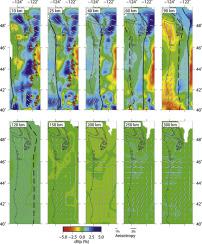Physics of the Earth and Planetary Interiors ( IF 2.3 ) Pub Date : 2021-07-03 , DOI: 10.1016/j.pepi.2021.106767 Dapeng Zhao 1 , Yuanyuan Hua 1, 2

|
The first P-wave tomography of 3-D azimuthal and radial anisotropy of the Cascadia subduction zone is determined by inverting local and teleseismic arrival-time data. Fast-velocity directions (FVDs) of azimuthal anisotropy in the crust are generally trench-parallel, reflecting N-S compression along the Cascadia margin. Radial anisotropy (RAN) is negative (i.e., Vpv > Vph) in the crust and upper-mantle wedge beneath the Cascadia volcanoes and back-arc area, reflecting hot and wet upwelling flows associated with fluids from dehydration reactions of the young and warm Juan de Fuca plate that is subducting toward the northeast. Trench-parallel FVDs occur in the subducting slab under the forearc, suggesting that the gently-dipping slab may still keep its original anisotropy produced at the mid-ocean ridge and modified at the outer-rise before subduction. The slab and subslab mantle exhibit the same RAN pattern: positive RAN in the Cascadia forearc whereas negative RAN under the Cascadia volcanoes and the back-arc. This feature suggests that the slab and the subslab asthenosphere are strongly coupled, and subslab mantle flow is formed by entrainment of the asthenosphere with the overriding slab. In northern Cascadia, NE-SW FVDs occur in a prominent subslab low-velocity zone that also exhibits negative RAN, reflecting thermally buoyant mantle materials derived from nearby oceanic hotspots, which flow toward the northeast and gradually accumulate under northern Cascadia, resulting in decompression melting.
中文翻译:

卡斯卡迪亚俯冲带的各向异性断层扫描
卡斯卡迪亚俯冲带的 3-D 方位角和径向各向异性的第一次 P 波断层扫描是通过反转局部和远震到达时间数据来确定的。地壳中方位角各向异性的快速度方向 (FVD) 通常与海沟平行,反映了沿卡斯卡迪亚边缘的 NS 压缩。卡斯卡迪亚火山和弧后区域下方的地壳和上地幔楔中的径向各向异性 (RAN) 为负值(即 Vpv > Vph),反映了与年轻和温暖的 Juan 脱水反应产生的流体相关的湿热上升流de Fuca 板块向东北俯冲。与海沟平行的 FVDs 出现在前弧下方的俯冲板片中,这表明缓倾板片可能仍保持其在洋中脊产生的原始各向异性,并在俯冲前在外上升发生改变。板坯和亚板坯地幔表现出相同的 RAN 模式:在卡斯卡迪亚弧前为正 RAN,而在卡斯卡迪亚火山和弧后为负 RAN。这一特征表明板块和亚板块软流圈是强耦合的,亚板块地幔流是由软流圈与上覆板块的夹带形成的。在卡斯卡迪亚北部,NE-SW FVDs 出现在显着的亚板层低速区,该带也表现出负 RAN,反映了来自附近海洋热点的热浮地幔物质,这些物质流向东北并逐渐在卡斯卡迪亚北部下方积聚,导致减压熔化. 板坯和亚板坯地幔表现出相同的 RAN 模式:在卡斯卡迪亚弧前为正 RAN,而在卡斯卡迪亚火山和弧后为负 RAN。这一特征表明板块和亚板块软流圈是强耦合的,亚板块地幔流是由软流圈与上覆板块的夹带形成的。在卡斯卡迪亚北部,NE-SW FVDs 出现在显着的亚板层低速区,该带也表现出负 RAN,反映了来自附近海洋热点的热浮地幔物质,这些物质流向东北并逐渐在卡斯卡迪亚北部下方积聚,导致减压熔化. 板坯和亚板坯地幔表现出相同的 RAN 模式:在卡斯卡迪亚弧前为正 RAN,而在卡斯卡迪亚火山和弧后为负 RAN。这一特征表明板块和亚板块软流圈是强耦合的,亚板块地幔流是由软流圈与上覆板块的夹带形成的。在卡斯卡迪亚北部,NE-SW FVDs 出现在显着的亚板层低速区,该带也表现出负 RAN,反映了来自附近海洋热点的热浮地幔物质,这些物质流向东北并逐渐在卡斯卡迪亚北部下方积聚,导致减压熔化. 这一特征表明板块和亚板块软流圈是强耦合的,亚板块地幔流是由软流圈与上覆板块的夹带形成的。在卡斯卡迪亚北部,NE-SW FVDs 出现在显着的亚板层低速区,该带也表现出负 RAN,反映了来自附近海洋热点的热浮地幔物质,这些物质流向东北并逐渐在卡斯卡迪亚北部下方积聚,导致减压熔化. 这一特征表明板块和亚板块软流圈是强耦合的,亚板块地幔流是由软流圈与上覆板块的夹带形成的。在卡斯卡迪亚北部,NE-SW FVDs 出现在显着的亚板层低速区,该带也表现出负 RAN,反映了来自附近海洋热点的热浮地幔物质,这些物质流向东北并逐渐在卡斯卡迪亚北部下方积聚,导致减压熔化.



























 京公网安备 11010802027423号
京公网安备 11010802027423号